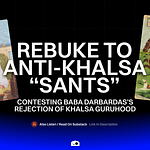I highly recommend going and reading it for yourselves, as SI also provides a list of counter-measures Sikhs could, and probably should, implement to guard ourselves against anyone wanting to employ those tactics.
What I wanted to convey in the following was some of my own thoughts after reading it, to help highlight and further this important discussion.
As I read SI’s analysis, I was immediately reminded of Chanakya Niti, studied historically in the Anandpur Darbars of Guru Gobind Singh and even transcreated by Kavi Sainapati, author of Gur Sobha. In particular, the concept of "Bhed," the fourth element of the strategy set Saam, Daam, Dand & Bhed, came to mind.
Saam — Negotiation, reconciliation and persuasion
Daam — Material inducement or offering monetary or other material incentives
Dand — Physical Punishment through the use of force
Bhed — Division or sowing discord
— Read more about these, here.
Bhed involves sowing division within enemy ranks — a highly effective strategy against centralised forces, disrupting cohesion and progress by turning internal elements against each other. However, when confronting a decentralised or federated structure, this strategy becomes significantly more challenging.
Those forces that are sufficiently federated or decentralised, are like a network of nodes, so that if any one goes down, numerous others are still operational, pursuing the same overarching objectives independently. In fact, this may also help increase the likelihood of success as well, since it encourages a kind of economic competition that we see in free-market systems as well, where multiple private entities are trying to "one-up" each other to produce a better product or service and to secure a profit. Each company (node) in the market (network) may have its own corporate policies, organisational structures, and unique selling points to leverage in order to compete.
Those familiar with my stances would know that I am a strong proponent of implementing a similar approach for the Guru Khalsa. The Azadist conception of a Modernised Misl System is built upon this idea of decentralisation, where each Misl establishes their own Maryadai, relevant to their own situation and contexts. They could also determine their own hierarchy structures as well, management styles, recruitment criteria, uniforms etc. But what is the Khalsa's role or objective? Khalsa Raaj.
How it will work and how you get there, again, doesn't need to have a unified, Panth wide consensus, rather, those Misls who clearly lay out a vision and a roadmap will be able to validate their ideas by trying it. The Panth will see which interpretations, Maryadai, organisational structures etc were most effective by virtue of their results. Other Misls can take those learnings and incorporate it or adapt it, thereby increasing general innovation towards establishing lots of Raaj, all contributing to a global Khalsa Raaj.
This way not all our eggs are in one basket, and it makes the task of an external, hostile force very difficult since they would need to devise bespoke strategies for each Misl, who would similarly be devising bespoke defence strategies in this competitive and innovative environment. Once one Misl goes down, it would communicate lessons to other Misls who adjust to avoid the same pitfalls. A hostile actor may be able to take down a few nodes in this network, but it is very difficult to take down the entire network in one go as it is with a centralised system, with a single point of failure.
Historically, when the Panth attempted Misls before, forces like those of Abdali never managed to destroy the Khalsa during his time through his military efforts, and instead the Khalsa bounced back stronger than ever. With modern technology, even small units can overpower a much larger foe. The democratisation of technology is a great equaliser.
No external force dismantled the Misl system, it was our own attempts under Maharaja Ranjit Singh to centralise that brought it to an end. And the only reason he could do this was precisely because you had only a handful of Misls — there was not enough decentralisation! But if you had hundreds, thousands, perhaps hundreds of thousands of Misls, then it becomes an near impossible task to bring them all under one banner (which M.Ranjit Singh didn't do entirely either).
I recommend reading or listening to the Dharam Yudh Pipeline White Paper published by Bunga Azaadi for a vision for a modernised Misl system and how to get there, taking into account the lessons from our Panth's attempt at it prior.
But for now, it is imperative to highlight that that we as a Panth today must become effective at operating in a decentralised manner. This requires institutions that can arbitrate disputes in peaceful and professional ways, thereby offering alternative avenues to express disagreement that is far less resource intensive than a physical, violent conflict between nodes/Misls.
As SI mentioned in their article, having "Conflict Mediation Units" will be key. Bunga Azaadi offers a structured debate format that we are trailing at the moment on more general topics, but there is no reason why the same format can't be used as part of dispute arbitration processes by a whole industry of Sikh conflict resolution organisations (a type of modern Misl). And there should be many of them to choose from, not just one.
If we try to centralise authority in a single or handful of Takhts, that are already dysfunctional in many regards, let alone in their ability to arbitrate disputes (you could even argue they are a source of it), then you will establish single points of failure that everyone becomes reliant on, which in turn become big targets for enemies to try and corrupt or even dismantle on their terms. But if we already as a Panth, redefine how we understand Takhts, not to be these circuses for Sikh Popes and attempts at a kind of Sikh Catholicism, but actual Khalsa political buildings, forward operating bases or embassies, with very specific focuses, all over the world serving as platforms to deliberate amongst Misls, then if any one becomes corrupted or dysfunctional, the Misls can easily switch to another or set up new ones. When it comes to Raajniti, fluidity, flexibility and functionality is paramount for political success. More on this concept can be found in our Sikh Spaces section of Bunga Azaadi's Vichaar Repository at BungaAzaadi.com.
Therefore, within this decentralised context, I do believe that some strategic division can be good, the same way how rejecting unity with a tumour can save the rest of the body. This applies to institutions and individuals. But it also matters how you do this.
For instance, those who agree on 90% of things, shouldn't allocate so much resource and time exacerbating the 10% they disagree on. But equally, that 10% shouldn't be brushed under the carpet and ignored either, otherwise, like a cancer, it will fester and spread, and get to a point where Charcha & Vichaar is no longer a viable treatment. Hence why we must make efforts to debate and offer opportunities to share disagreements in a healthy way as a Panth before we get to points of no return.
Having a diversity of interpretation, praxis, objectives etc can make our Panth strong and resilient, the same way how an alloy is stronger than a "pure" metal, precisely because its a mixture of various metals.
Ultimately, there is a balance to be struck here. We don't want to be blind to foolishness, maliciousness and become cowards who won't hold those who act in our name accountable, but we also don't want to descend into endless, debilitating infighting either which wastes our time and resources.
Our Gurus themselves demonstrated this principle, engaging in boycott when necessary, clearly marking boundaries against and calling out bad faith actors. They were not afraid of apparent division when it served greater unity and integrity. Thus, the real caution is against allowing our differences to become distractions. Unity should not mean uniformity, and diversity should not drag us into divisiveness. Navigating this balance thoughtfully is key to our resilience and strength as a Panth. But we must do both. We must purge those no longer willing to engage in meaningful, good-faith discourse and work counter-productively to our collective interests, otherwise they will distract and destroy. Those of us who are genuine in our desire for Khalsa Raaj must collaborate, as independent, self-autonomous sovereigns in our own right, but compromise and build on what we align on to serve mutual interests whilst respecting each other's jurisdictions.
To summarise, I think some valid calls to action, alongside many of those SI suggested in their article, would be to decentralise the Panth strategically. We need to get "all of our eggs out of one basket" so to speak, and work towards Mislisation. The Dharam Yudh Pipeline is a strategy being implemented currently and if you would like to support it, get in touch. Another aspect is to develop new Takhts as Khalsa political buildings and embassies wherever there are Sikh populations centres in the world. The primary functions of these should serve as meeting places for modern Khalsa Misls to mobilise, coordinate activity, conduct debate and discussion and mediate intra-Misl conflicts peacefully and professionally. The Sikh Spaces section of the Vichaar Repo is the place to visit for more information about this.
Fundamentally, we have to destroy our attachment to things that are not working and rapidly innovate to find better, more effective ways. If our principles are solid, our techniques can be fluid. Just like Guru Gobind Singh dismantled the Masands when they became degenerate, even though it was a system set up by the prior Gurus, the Guru Khalsa Panth today, by virtue of its status as Guru, has the authority to adapt also. We must also foster collaboration amongst those who share the same general vision and support each other by making up for weaknesses and building on each other's strengths.
Lastly, if you are passionate about Panthic progress and development, as well as resilience and longevity, then consider supporting its think tanks working to devise strategies and putting them into practice. We can only do this with your support, so subscribe, give patronage, or get involved with institutions like Sarbloh Institute and Bunga Azaadi to help us, help the Panth to in turn help all humanity.

















Share this post